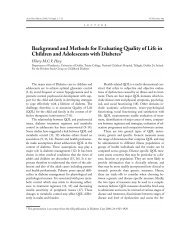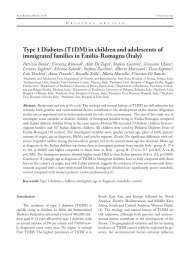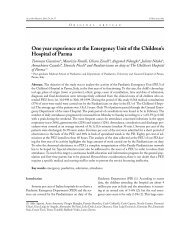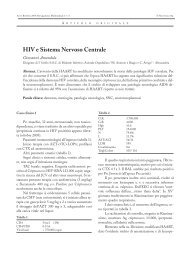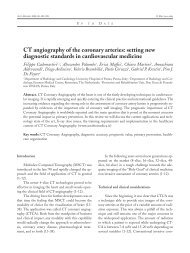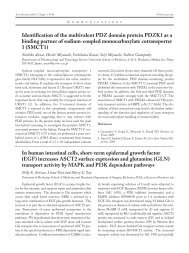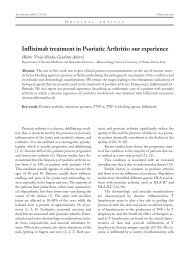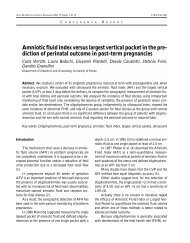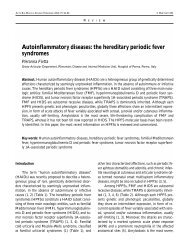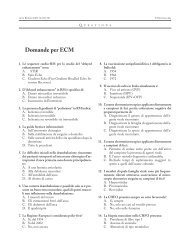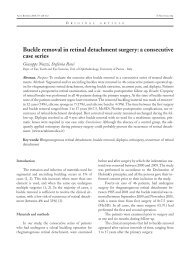Inhalatory therapy training - Acta Bio Medica Atenei Parmensis
Inhalatory therapy training - Acta Bio Medica Atenei Parmensis
Inhalatory therapy training - Acta Bio Medica Atenei Parmensis
Create successful ePaper yourself
Turn your PDF publications into a flip-book with our unique Google optimized e-Paper software.
ACTA BIOMED 2007; 78: 233-245 © Mattioli 1885<br />
F O C U S O N<br />
<strong>Inhalatory</strong> <strong>therapy</strong> <strong>training</strong>: a priority challenge for the<br />
physician<br />
Andrea S. Melani<br />
Respiratory Physiopathology and Rehabilitation, Cardiothoracic Department, Polyclinic “Le Scotte”, “Azienda Ospedaliera<br />
Universitaria Senese”, Siena (Italy)<br />
Abstract. Patients with asthma and COPD commonly use inhaled drugs. The 3 types of currently available<br />
devices for inhaled <strong>therapy</strong> (Metered-dose inhaler, dry powder inhaler, and nebulizer) are clinically equivalent.<br />
However, since many different inhalers are available for inhaled <strong>therapy</strong>, the choice of the delivery device<br />
is important for optimizing the results of aerosol <strong>therapy</strong>.Traditional press-and-breathe Metered Dose<br />
Inhalers (pMDIs) have recently improved their ecological appeal, can be used in every clinical and environmental<br />
situation, their dosing is convenient and highly reproducible, but their efficient delivery remains<br />
highly technique dependent. Poor inhalation technique can be minimised by the use of add-on valved holding<br />
chambers, which are seldom used in the clinical practice possibly because they are cumbersome. Breath<br />
Actuated devices (BAIs), such as Dry Powder Inhalers (DPIs), which are environmental-friendly, safe, effective,<br />
reliable, portable and self-contained, overcome problems of handbreath co-ordination associated<br />
with pMDIs usage, but their use is also undermined by common errors of inhalation technique in real life.<br />
Nebulizers are cumbersome and time-comsuming for use and maintenance, but their use needs less cooperation<br />
than inhalers. Although nebulizer practice is not always evidence-based, some patients, mainly elderly<br />
prefer nebulizers for regular long-term usage. Despite the introduction of newer devices, clear advantages<br />
of a particular delivery system over other inhalers in terms of compliance, preference, and cost-effectiveness<br />
are not currently available. The objective of an ideal and easy-to use inhaler is far from reality. Patient<br />
education is the critical factor in the use and misuse of delivery devices and effectiveness of aerosol<br />
<strong>therapy</strong>. The choice of the device has to be tailored according to the patient’s needs, situation, and preference.Whatever<br />
the chosen inhaler, education from health caregivers has a key-role for improving inhaler<br />
technique and compliance. Differences among delivery devices represent another challenge to patient use<br />
and caregiver instruction. (www.actabiomedica.it)<br />
Key words: Inhaler, nebulizer, asthma, COPD, spacer, aerosol administration, drug delivery, compliance,<br />
clinical practice<br />
Introduction<br />
Nowadays the most common chronic bronchopulmonary<br />
diseases, such as asthma and COPD, are<br />
mainly treated by inhaled <strong>therapy</strong> (1-3). It is interesting<br />
to note that this practice became widespread<br />
many years after the introduction (through other administration<br />
routes) of atropine and adrenaline, the<br />
prototypes of the most widely used bronchodilators<br />
(4), only when efficient nebulizer ampoules (5) and<br />
inhalers (6, 7) finally became available.<br />
Physicians currently have a choice of 3 types of<br />
dispensers for lung deposition of drugs: A) nebulizers,<br />
B) pressurized inhalers and C) the dry powder inha-
234 A.S. Melani<br />
lers; many models of each type are available, all of<br />
them with advantages and disadvantages (Table 1),<br />
but none with ideal properties (Table 2).<br />
Unfortunately the physician often simply prescribes<br />
inhaler <strong>therapy</strong>, taking for granted that the patient<br />
will carry it out properly, whereas the majority of patients<br />
does not realize that the efficacy of inhaler <strong>therapy</strong><br />
often depends on whether it is carried out correctly.<br />
On the other hand, not only does the National<br />
Health Services not support educational activities which<br />
aim to teach patients how to correctly use the prescribed<br />
inhalers, but they do not even request minimum<br />
efficacy requirements to enable new aerosol <strong>therapy</strong><br />
devices to be marketed and they also supply generic<br />
drugs for inhalation use by referring only to the active<br />
ingredient and not to the inhaler delivering it.<br />
Pressurized inhalers<br />
The metered-dose pressurized inhalers (hereinafter<br />
“spray”) are pocket-sized, scarcely affected by environmental<br />
influences, work autonomously, are efficient,<br />
and contain and accurately deliver many doses of<br />
aerosol in a short time. Although many types of sprays<br />
are available on the market with very different characteristics,<br />
the shape, the dimensions and the mechanism<br />
of action is substantially similar for all of them<br />
(apart from the types, of which only the Autohaler ® is<br />
available in Italy, in which the aerosolization is determined<br />
by the user’s inhalation once the delivery device<br />
is switched on) (8, 9). Despite this apparent immutability,<br />
a great effort has been recently made to replace<br />
the old chlorofluorocarbon propellants (CFC), since<br />
they are not environmentally friendly, with the new<br />
hydrofluoroalkanes (HFA), which ensure a lower environmental<br />
impact (10). This means that new formulations<br />
have been produced which have partly contributed<br />
to the improvement of some characteristics (e.g.<br />
lower granulometry, less need to coordinate deliveryinhalation)<br />
(11-19). A counter has been inserted in the<br />
salmeterol/fluticasone combination in order to identify<br />
the remaining doses of aerosol (Fig. 1). This is an undoubted<br />
practical advantage compared to the traditional<br />
sprays (20), for which the only way of avoiding the<br />
risk of delivering an aerosol with less or no active ingredient<br />
by exceeding the inhaler’s stated dose limit<br />
(24), was to keep a tally (rarely done) of the doses already<br />
delivered (21-23).<br />
The sprays main limitation was and is still linked<br />
to the fact that many patients cannot use them correctly<br />
(Table 3), and this can reduce or even eliminate the<br />
potential for clinical efficacy (25, 26). More than 30<br />
years ago Crompton (27) estimated that approximately<br />
half of all users were unable to use the sprays carried<br />
out and the current situation appears to be little<br />
improved (28): in a recent study conducted in a pneumology<br />
department in Italy on a sample of adult pa-<br />
Table 1. Main properties of nebulizers and inhalers<br />
Characteristics Nebulizers Inhalers (both pressurized and dry<br />
powder types)<br />
Retail sales method Drug and device sold separately Drug and device sold together<br />
Accurate drug delivery with optimal use Light Good<br />
Aerosolization time Long (several minutes) Short (few seconds)<br />
Need for maintenance After each use No<br />
Weight Varies, but always significant Light (few grams)<br />
Dimensions Vary, but not pocket-size Pocket size<br />
Active cooperation required by user for No Yes<br />
optimal use<br />
Operating method Requires external energy source Autonomous<br />
Availability With every drug With some drugs
<strong>Inhalatory</strong> <strong>therapy</strong> <strong>training</strong><br />
235<br />
Table 2. Characteristics of an ideal inhaler<br />
Little oropharyngeal deposition of drug<br />
Excellent lung deposition of drug<br />
Lightweight and pocket-sized<br />
Little or no unfavourable ecological impact<br />
May be used in all clinical and environmental circumstances<br />
May be used without the need for accessories and/or external<br />
power sources<br />
Must contain enough drug for many aerosolizations<br />
Possibility of counting the delivered and the residual doses<br />
Little or no possibility of the degradation or contamination of<br />
the active ingredient with use<br />
Ease of use without or with minimum need for collaboration by<br />
user or the caregiver and system for checking whether optimum<br />
aerosolization of the dose has taken place<br />
No additives, propellants or excipients<br />
Active ingredient accurately released in each dose and in all environmental<br />
conditions<br />
It must quickly aerosolize the dose of the drug, with the possibility<br />
of repeating the delivery if necessary several times immediately<br />
afterwards<br />
Needs little or no maintenance<br />
May be used with any drug which has potential clinical efficacy<br />
when administered via aerosol<br />
Good cost-effectiveness<br />
Figure 1. Metered-dose pressurized inhaler with dose counter<br />
for delivery of the salmeterol/fluticasone propionate combination<br />
tients who had been using the sprays at home for some<br />
time, the frequency of errors of inhalation technique<br />
which significantly or completely reduce lung deposition<br />
of the aerosolized drug (defined as critical errors<br />
below), was approximately 20% of the total (29).<br />
An alternative technique for those who cannot<br />
manage hand-breath coordination is the addition of a<br />
spacer to the spray. There are various types of spacers,<br />
all distinguished by the characteristic of adding “volume”<br />
between the canister and the user. The best results<br />
are obtained with spacers provided with one-way valves.<br />
The user inhales the aerosolized drug in the spacer<br />
but does not exhale into it (Fig. 2) (30). Spacers are<br />
also useful for administering the drugs by inhalation<br />
to non-cooperating subjects or those on a ventilator,<br />
since less of the active drug impacts on the oropharyngeal<br />
area and more is deposited in the lungs. However,<br />
the use of spacers remains limited, perhaps because<br />
they are cumbersome, meaning that the spray is no<br />
longer pocket-sized: in 2000, the percentage of adults<br />
treated in pneumology departments in Italy using<br />
inhalation chambers was slightly less than 18% of the<br />
total number of subjects using sprays (29), whereas a<br />
larger number, approximately 35% was reported for<br />
asthmatic children treated by pediatricians (31).<br />
Another disadvantage of the spacer chambers is<br />
the need for routine maintenance with a standardized<br />
procedure (washing with water and washing up liquid is<br />
recommended at least once a week, followed by leaving<br />
it to dry instead of drying it with a cloth!) in order to<br />
reduce the electrostatic charges which may unfavourably<br />
interact with the aerosol delivered; some new spacers,<br />
such as the NebuChamber®, Vortex®, Fluspacer®,<br />
OptiChamber® or AeroChamber Plus®, develop these<br />
negative interactions less frequently (30, 32).<br />
Dry powder inhalers<br />
Just like the pressurized inhaler, dry powder inhalers<br />
are pocket sized, efficient and do not require any<br />
external source of energy to deliver the aerosol. Unlike<br />
the sprays, which are substantially all characterized by<br />
a similar exterior appearance and operating procedure,
236 A.S. Melani<br />
Table 3. Spray inhalation techniques: percentage of errors in real life compared to the recommended procedure and clinical consequences<br />
Phase of recommended inhalation technique Percentage of non-compliance Clinical consequence of<br />
with the recommended procedure non-compliance<br />
Removing the cap from the mouthpiece + X<br />
Shaking the inhaler immediately before use” ++ -<br />
Emptying or almost emptying the lungs before activating the spray +++ -<br />
Placing the mouthpiece in the mouth, closing lips around it and<br />
avoiding any obstruction by the tongue; or placing the mouthpiece<br />
approximately 3-4 cm in front of the mouth, which is kept wide open + from - to X<br />
Keeping the spray with the longest part pointing upwards during delivery ++ -<br />
Activating the inhaler once only with a single inhalation $ ++ -<br />
Activating the inhaler during the first half of inhalation +++ from -- to X<br />
Slowly inhaling while activating the inhaler +++ --<br />
Continuing to fill the lungs completely without stopping after delivery +++ --<br />
of the dose<br />
Holding breath for at least 8-10 seconds or for as long as possible when +++ --<br />
inhalation is complete<br />
$ = if the spray had not been used in the previous 3-4 days, it is advisable to deliver 1-2 puffs without inhaling; Noncompliance reported occasionally<br />
= +; Noncompliance reported quite frequently (up to 20-25% of the total) = ++; Noncompliance reported frequently (up to and more<br />
than 50% of the total) = +++; Clinical consequence of this variety of misuse is slight = -; Clinical consequence of this variety of misuse is moderate<br />
= --; Critical error, such as to reduce drug lung deposition totally = X<br />
the various dry powder inhalers differ due to morphology<br />
(Table 4) and method of use.<br />
Technical errors in use made by patients instead<br />
of the recommended procedure, have also been reported<br />
for the dry powder dispensers (Tables 5, 6). Some<br />
are single-dose systems, in which the drug is contained<br />
in a capsule which must be inserted in the appropriate<br />
housing of the dispenser each time immediately<br />
before inhalation. Others, known as multiple-dose di-<br />
Figure 2. Example of spacer chamber (with a one-way valve to<br />
ensure the content of the chamber is inhaled, while the exhaled<br />
air is directed outside, as indicated by the arrows)<br />
Table 4. Dry powder inhalers currently marketed in Italy<br />
Inhaler<br />
HandiHaler<br />
Diskus<br />
Turbohaler<br />
Aerolizer<br />
Novolizer<br />
Pulvinal<br />
Drugs dispensed<br />
Tiotropium<br />
Salmeterol, fluticasone,<br />
Formoterol, budesonide, formoterol/<br />
budesonide, terbutaline<br />
Formoterol, budesonide<br />
Budesonide<br />
BDP
<strong>Inhalatory</strong> <strong>therapy</strong> <strong>training</strong><br />
237<br />
Table 5. Inhalation technique with single-dose dry powder inhaler: error percentage in real life compared with the recommended<br />
procedure and clinical consequences (25)<br />
Inhalation technique phase Percentage of non-compliance Clinical consequence<br />
with the recommended procedure of non-compliance<br />
Removing the cap + X<br />
Opening the appropriate inhaler housing inserting the capsule + from - to X<br />
immediately before use and closing it correctly<br />
Pressing the buttons situated at the base of the inhaler at the + from - to X<br />
same time in order to break the capsule containing the drug<br />
Emptying the lungs to avoid exhaling into the inhaler after ++ --<br />
breaking the capsule<br />
Placing the mouthpiece in the mouth, closing lips around it and + from – to X<br />
avoiding any obstruction with the tongue<br />
Inhaling with maximum inhalatory force from the start +++ from – to X<br />
Stopping inhalation only after filling the lungs completely ++ -<br />
Removing the inhaler from the mouth without exhaling into it ++ -<br />
Checking whether the capsule is empty after use and if there is still + -<br />
some powder, repeating the inhalation, removing it, closing the<br />
mouthpiece and replacing the cap<br />
Closing the inhaler + -<br />
+; ++; +++; -; —; X = see key Table 3<br />
Table 6. Inhalation technique for multiple-dose powder inhaler: error percentage in real life compared with the recommended procedure<br />
and clinical consequences (25)<br />
Inhalation technique phase Percentage of non-compliance Clinical consequence<br />
with the recommended procedure of non-compliance<br />
Removing inhaler cap/opening the dispenser + X<br />
Loading the dispenser sufficiently° + X<br />
Emptying the lungs, avoiding exhaling into the inhaler after loading ++ --<br />
Placing the mouthpiece in the mouth, closing lips around it and + from – to X<br />
avoiding any obstruction with the tongue<br />
Inhaling with maximum inhalatory force from the start^ +++ from – to X<br />
Stopping inhalation only after filling the lungs completely ++ -<br />
Removing the inhaler from the mouth without exhaling into it* ++ -<br />
Closing the inhaler + -<br />
°In some cases this phase is position-sensitive, for example the Turbohaler’s longest axis must be arranged vertically or at an angle no greater<br />
than 15-20° out of the vertical; * for reservoir inhalers such as the Turbohaler, the humidity of the exhalation can cause the powder to clump<br />
and worsen aerosolization in subsequent inhalations; ^especially with Turbohaler which contains little or no excipient, the user must be warned<br />
that even well-performed inhalations may not be accompanied by any perception or taste in the mouth; see key Table 3
238 A.S. Melani<br />
Dispenser site<br />
Mouthpiece<br />
Mainfold<br />
Index<br />
Cover private<br />
blister<br />
Body<br />
DROUG-DOSE<br />
COUNTER<br />
Empty<br />
blister<br />
Flow wheel<br />
Basis<br />
wheel<br />
Wrapped blister<br />
Alveolus<br />
containing drugs<br />
Lever<br />
Drug dose<br />
indicator<br />
Thumb notch<br />
External case<br />
MOUTHPIECE<br />
LEVER<br />
Figure 3. Multiple-dose dry powder inhaler (Diskus), the arrow on the right indicates the dose-counter<br />
spensers, contain enough drug in the inhaler for many<br />
deliveries; each dose may be ready for use (the prototype<br />
is the Diskus®), (Fig. 3) (33), or may be drawn<br />
from a reservoir while loading (the prototype for these<br />
systems is the Turbohaler®) (34).<br />
All the multiple-dose powder inhalers include systems<br />
(more or less sophisticated) which count the doses<br />
administered and those remaining. Just like the<br />
sprays, the dry powder dispensers do not require any<br />
proper maintenance, but only regular cleaning.<br />
The main advantages of the dry powder inhalers<br />
over the sprays are shown as follows:<br />
a) they are ecologically compatible, they do not<br />
require propellant for aerosolization;<br />
b) they are activated when the user inhales and do<br />
not require any hand-breath coordination<br />
The main disadvantages are:<br />
a) they are impossible to use in non-cooperating<br />
patients, or in those who are ventilated or tracheostomized,<br />
or to add a spacer to;<br />
b) the aerosol drug output (35) is less accurate<br />
and reproducible, especially in a situation with<br />
high humidity and high surrounding temperature<br />
(36-39), particularly in the multiple-dose,<br />
reservoir devices such as Turbohaler;<br />
c) the fear that patients with serious ventilatory<br />
impairment would not be able to generate the<br />
Nebulizers<br />
flows and volumes required for adequate inhalation:<br />
this can happen in the case of children or<br />
patients in more serious clinical situations,<br />
especially when high-resistance dispensers such<br />
as HandiHaler or Turbohaler are used (40-42).<br />
Nebulizers are essentially able to convert any liquid<br />
into an aerosol. There are two fundamental classes<br />
of nebulizers: mechanical nebulizers – which<br />
amount to no less than 90% of the total used at home<br />
for pneumological reasons (43) – and the ultrasound<br />
types. Numerous models are available on the market<br />
for each class, even though none of them comes close<br />
to the ideal device (Table 7) (44).<br />
It is important to remember that very few studies<br />
have been carried out with strict methodologies to<br />
compare the characteristics of the various nebulizers,<br />
but where data is available, it reveals substantial differences<br />
between the different models regarding both<br />
aerosol emission and the dimensions of the particles<br />
emitted (45).<br />
The traditional ultrasound types are very compact,<br />
less noisy than the mechanical types and provide<br />
a greater aerosol output per unit of time (46), but are
<strong>Inhalatory</strong> <strong>therapy</strong> <strong>training</strong><br />
239<br />
Table 7. Main characteristics of an ideal nebulizer<br />
High aerosol output per unit of time<br />
High efficiency<br />
Reproducible performance in different operating conditions<br />
Reduced energy consumption when functioning<br />
Easy to use<br />
Possibility for the patient to check whether the nebulization<br />
was carried out correctly and the system was operating optimally<br />
Easy, reduced maintenance<br />
Not cumbersome<br />
Robust<br />
Little noise<br />
not recommended for nebulizing corticosteroids (47).<br />
The mechanical nebulizers usually include a compressor<br />
(more often in hospitals the source of compressed<br />
gas is centralized with wall-mounted connection devices<br />
available), a nebulizing ampoule, an interface with<br />
the patient (mouthpiece or nose mask), and the tubes<br />
connecting these different components; only recently<br />
all these components were made into a more compact<br />
system, such as the Clenny®, although still not<br />
pocket-sized. The nebulizer ampoule is the essential<br />
part of the mechanical nebulizer; some are made of<br />
glass (not recommended!) and some in plastic; singleuse<br />
versions, which generally work well for several nebulizations,<br />
and reusable versions, can remain efficient<br />
for up to a year if suitably maintained. The traditional<br />
ampoules continuously produce the aerosol which is<br />
only inhaled when the user breathes in, leading to a<br />
considerable waste of nebulized drug; nowadays, the<br />
introduction of additional openings in the ampoules,<br />
provided with one-way valves which allow the passage<br />
of air during inhalation but not during exhalation, selectively<br />
increases the aerosol emission and the percentage<br />
of fine particles; these ampoules, known as<br />
breath-enhanced ampoules, are available on the<br />
market at only a slightly higher cost than the traditional<br />
ones, and are recommended if expensive drugs such<br />
as cortisone need to be repeatedly nebulized. A<br />
good nebulizer should complete a single nebulization<br />
in less than 10 minutes (48), whereas GENebu studies<br />
conducted in Italy in 1999 on adults who used a nebulizer<br />
at home, showed that the duration of an individual<br />
nebulization exceeded 15 minutes in 36% of cases<br />
(43); this confirms the need for significant <strong>training</strong><br />
in this field.<br />
Solutions and suspensions may be distinguished<br />
according to the level of solubility of the drug in the<br />
solvent: bronchodilators are habitually formulated as<br />
solutions and nebulize relatively simply, the cortisones,<br />
in suspensions, have greater requirements (the<br />
ampoule for which there is evidence of clinical efficacy<br />
is the Pari LC Plus® with budesonide) for nebulization<br />
(47). The possibility of mixing more drugs in a<br />
single nebulization is a widespread practice used both<br />
at home and in the hospital (49): most nebulizer use<br />
at home in Italy includes mixtures of several drugs, almost<br />
always including corticosteroids (43). From the<br />
limited available data it seems that, if the beta-agonists<br />
are mixed with the anticholinergics immediately<br />
before nebulization, there are no negative interactions,<br />
such as between bronchodilators and mucolytics or<br />
antimicrobics, but mixing mucolytics and antimicrobics<br />
may have a negative influence on the nebulization<br />
of the latter (50).<br />
Studies carried out by the manufacturer do not<br />
report any negative interactions when budesonide is<br />
mixed with bronchodilators (51), but mixing beclomethasone<br />
diproprionate (NDP) or flunisolide with<br />
bronchodilators in vitro considerably reduces the percentage<br />
of breathable particles compared with nebulization<br />
of the individual active ingredients (52, 53).<br />
Buffers and antibacterials, which can sometimes<br />
cause bronchoconstriction that may be severe, are often<br />
added in order to increase the half-life of the formulations<br />
and to reduce the risk of contamination.<br />
The risk of contamination by microorganisms in<br />
nebulizing aerosols has been known for many years;<br />
the cause of the contamination has often been attributed<br />
to the use of multiple dose solutions of drugs and<br />
solvents or to the watery residue which remains in the<br />
ampoules if they are not regularly dried after each nebulization.<br />
Contamination is often due to particularly<br />
insidious germs such as Pseudomonas aeruginosa,<br />
methicillin-resistant Staphylococcus aureus Burkholderia<br />
cepacia, and Stenonotrophomonas maltophilia (53).
240 A.S. Melani<br />
Unfortunately regular nebulizer hygiene procedure<br />
is rarely carried out, both in the hospital and at<br />
home. Data from the GENebu Project show that approximately<br />
60% of adults have never received instructions<br />
on nebulizer maintenance from physicians,<br />
even though the fact that patients who had received<br />
such instructions carried out hygiene procedures more<br />
often, was reassuring (54).<br />
In order to reduce the risk of the bacterial contamination<br />
of therapeutic aerosols it is necessary to carry<br />
out the regular cleaning and disinfection procedure recommended<br />
by the manufacturer for nebulizer hygiene.<br />
On the other hand, errors in therapeutic nebulization<br />
procedures are often reported in hospitals as<br />
well, being often left to the individual experience of<br />
the physician, more often of a nurse, who carries it out<br />
without shared written procedures to follow (55-58).<br />
Choosing an inhalation drug delivery system<br />
(A)<br />
(B)<br />
Figure 4. Raman laser analysis of the preconstituted combination<br />
fluticasone-salmeterol (A) and of the extemporaneous<br />
combination (B) of the two drugs. The molecules emitted by<br />
the dispenser may be visually differentiated by virtue of their<br />
different colours: fluticasone and salmeterol may be identified<br />
by their colors, which are green and red respectively, whereas<br />
the yellow identifies the united particles of fluticasone and salmeterol<br />
(63)<br />
Some recent meta-analyses show that the clinical<br />
results for a given drug offered by different dispensers<br />
are substantially equivalent if used correctly (59, 60).<br />
Therefore in real life, when many dispensers are available<br />
for the aerosol delivery of a given drug, the choice<br />
must be made according to the clinical situation<br />
(60); when there are still more possibilities, the choice<br />
should be based on the preference of the user or caregiver<br />
and whether a good technique may be achieved<br />
for use. No strict methods for defining which dispensing<br />
system is preferable are shown, but many experts<br />
are convinced that inhalers are easier to use than nebulizers<br />
(48, 61).<br />
It has been observed that the treatment of patients<br />
with asthma or COPD, especially if moderate<br />
or serious, requires the regular administration of several<br />
drugs via inhalation. This has led, over the last few<br />
years, to the widespread use of drugs with long-lasting<br />
action and dispensers containing a combination of several<br />
drugs rather than individual drugs taken sequentially,<br />
thereby reducing the number of daily administrations<br />
and increasing treatment compliance, especially<br />
if treatment is long-term (62).<br />
The availability of preconstituted combinations<br />
of drugs in one dispenser can increase the clinical efficacy<br />
of the treatment, as well as encourage compliance.<br />
A study based on a spectroscopic analysis carried<br />
out with the “Raman” laser technique, has in fact<br />
shown that the particles of the corticosteroid fluticasone<br />
propionate and the bronchodilator salmeterol<br />
emitted from the same spray dispenser, tend to closely<br />
adhere to each other at a significantly greater degree<br />
than is observed when they are administered separately<br />
(Fig. 4) (63).<br />
This physical phenomenon seems to enable them<br />
to be deposited together in the airways, with an increased<br />
opportunity for synergic interaction in that site.<br />
This would explain the greater efficacy in respiratory<br />
parameters observed with the preconstituted<br />
combination fluticasone+salmeterol than with the two<br />
drugs administered separately (64).<br />
Indications in the guidelines<br />
With regards to the method of administration,<br />
the GINA guidelines for asthma management recom-
<strong>Inhalatory</strong> <strong>therapy</strong> <strong>training</strong><br />
241<br />
Figure 5. Effects of different types of <strong>training</strong> for the correct<br />
inhalation technique at the time of the first prescription and<br />
when checked at routine follow-up visits. Modified from (67).<br />
mend the use of inhaler <strong>therapy</strong>, which enables the<br />
user to achieve maximum efficacy with a minimum<br />
amount of adverse effects. It is recommended that<br />
younger children use the spray canister with the aid of<br />
a spacer and a face mask, in order to optimize lung deposition<br />
of the drug.<br />
Powder dispensers may also be used by cooperating<br />
children, aged over 6 years. Nebulizers are indicated<br />
as an alternative administration method which<br />
presents a series of disadvantages: inconvenient, cumbersome,<br />
lengthy administration, need for maintenance,<br />
no precision for inhaled dose. The GOLD guidelines<br />
for the treatment of COPD do not recommend<br />
the use of nebulizers for regular maintenance <strong>therapy</strong>.<br />
The ERS guidelines (65) on nebulizer use specify<br />
that:<br />
• the most common application for nebulizer <strong>therapy</strong><br />
is for the administration of short acting<br />
bronchodilators in patients with asthma and<br />
COPD.<br />
• Nebulizer <strong>therapy</strong> may be necessary in adult patients<br />
who are unable to use an inhaler, despite<br />
the appropriate spacer (Evidence C).<br />
• Nebulization continues to be used in hospitals<br />
because it is easier for healthcare staff to administer<br />
and requires less cooperation by the patient.<br />
• Nebulized corticosteroids used to treat flare-ups<br />
in adult and pediatric asthmatic patients, should<br />
be replaced by therapeutically equivalent doses<br />
of the drug administered more easily with a metered<br />
dose inhaler, with a spacer if necessary; in<br />
fact there is no evidence of any advantages obtained<br />
with nebulizers, which are more expensive<br />
and time-consuming (Evidence C).<br />
However, the most recent guidelines on asthma<br />
and COPD (1, 2) indicate that the most important requirement<br />
is that the chosen dispenser is used properly.<br />
This suggestion, based on the evidence that errors<br />
in use and maintenance are frequently made in all<br />
inhalation type drug dispensers, requires all medical<br />
staff to pay more attention to the educational aspects<br />
of inhalation <strong>therapy</strong> (28, 66).<br />
It has recently been shown that, such as with any<br />
type of inhaler, simply reading the package instructions<br />
does not appear to be sufficient to ensure proper<br />
use of the device, whereas only regular <strong>training</strong><br />
with practical examples, provided by the medical<br />
staff, represents an efficient strategy for reducing errors<br />
in inhalation technique (Fig. 5) (67), such as regularly<br />
checking the patient’s use of the dispenser<br />
(and correcting any errors) at each follow-up visit<br />
(Table 8).<br />
Other healthcare professionals should be involved,<br />
such as pharmacists (68-71), nurses (72) or physiotherapists<br />
(73), who in countries other than Italy<br />
have shown that they can play a significant <strong>training</strong><br />
role in this process of teaching patients to self-manage<br />
their inhalation <strong>therapy</strong>.<br />
Conclusions<br />
It appears clear that inhalation <strong>therapy</strong> is a complex<br />
treatment in which: a) the dispenser system is of<br />
huge importance in ensuring the efficacy of the <strong>therapy</strong>;<br />
b) in comparison with the nebulizers, the metered-dose<br />
inhalers are less cumbersome and more convenient<br />
to use at home, by stable patients; however,<br />
they can be used incorrectly, and this can jeopardize<br />
the clinical efficacy of the treatment; c) the best way to<br />
optimize inhaler technique and adherence to the prescribed<br />
treatment consists in accurate, repeated<br />
healthcare <strong>training</strong> on how and when to use the inhalers,<br />
rather than simply “changing” the dispenser.
242 A.S. Melani<br />
Table 8. Requirements for teaching the correct inhalation technique<br />
Work out a procedure for teaching each patient who comes for an appointment or to the pneumology department how to use the<br />
inhalers prescribed to them; alternatively never ask others to carry out this <strong>training</strong>.<br />
When the patient is prescribed an inhaler, give him/her a thorough explanation, without rushing, of each step of the inhalation technique,<br />
in a quiet room; then carry out the whole inhalation procedure yourself using a placebo inhaler, without stopping, in front<br />
of the patient.<br />
Ask the patient to bring his/her inhaler to each follow-up visit and observe him/her while he/she uses it.<br />
Correct any errors made by the patient until he/she has acquired the correct technique; if he/she does not manage to use it correctly,<br />
change the inhaler.<br />
Ask the patient if he/she feels comfortable using the prescribed inhaler or whether he/she prefers a different one. If necessary go<br />
back to the previous inhaler or explain why it was replaced.<br />
Inform the patient that the inhaler is to be used whenever necessary, if prescribed, and must always be kept in a pocket or handbag<br />
so that it is always immediately available when needed.<br />
Tell the patient to write down the date he/she started using the inhaler; to note down the times he/she uses the inhaler, if it does<br />
not have a dose-counter; to check the expiration date regularly; never to leave the inhaler where it is too cold, or in a hot, damp environment.<br />
If a spacer chamber has been prescribed, check how the patient uses it, whether he/she uses it regularly and whether the maintenance<br />
is carried out according to the method and times indicated in the manufacturer’s information sheet, or as suggested by the<br />
physician.<br />
In conclusion, we should like to emphasize that<br />
inhalation <strong>therapy</strong> is a complex procedure and a common<br />
effort is required in terms of education between<br />
physicians, users, and manufacturers of drugs and aerosol<br />
dispensers, in order to achieve the best results. In<br />
particular, the patient must acquire the conviction that<br />
without correct use and maintenance of the aerosol dispensing<br />
system, the clinical result will be reduced or<br />
eliminated; manufacturers should promote teaching activities<br />
aimed at the best use of therapeutic aerosols, by<br />
regularly providing the prescribing centers with placebo<br />
inhalers; the physicians and all medical staff who see<br />
patients using aerosol <strong>therapy</strong> should teach the “correct<br />
use” of the dispensers and regularly check that this has<br />
been learned and continues to be put into practice.<br />
References<br />
1. National Institute of Health. Global Initiative for Asthma.<br />
Global strategy for asthma management and prevention:<br />
NHLBI/WHO Workshop Report Bethesda, MD: National<br />
Institutes of Health 2002. Publication N° 02-3659.<br />
http://www.nhlbi.nih.gov/guidelines/asthma/asthmagdln.ht<br />
m. Ultimo accesso 01 Maggio 2007.<br />
2. National Institute of Health, National Heart, Lung and<br />
Blood Insitute. Global Initiative for Chronic Obstructive<br />
Lung Disease (GOLD). Global strategy for the diagnosis,<br />
management, and prevention of chronic obstructive pulmonary<br />
disease- updated 2003. Bethesda: National Institutes<br />
of Health, National Heart, Lung and Blood Institute.<br />
http://www.nhlbi.nih.gov/health/prof/lung/copd/<br />
copd_wksp.htm. Ultimo accesso 01 Maggio 2007.<br />
3. Celli BR, MacNee W. ATS/ERS Task Force: standards for<br />
the diagnosis and treatment of patients with COPD: a<br />
summary of the ATS/ERS position paper. Eur Respir J<br />
2004; 23: 932-46.<br />
4. Gandevia B. Historical review of the use of parasympatholitic<br />
agents in the treatment of respiratory disorders. Postgrad<br />
Med J 1975; 51 (Suppl. 17): 13-20.<br />
5. Muers MF. Overview of nebuliser treatment. Thorax 1997;<br />
52 Suppl. 2: S25-S30.<br />
6. Freedman T. Medihaler <strong>therapy</strong> for bronchial asthma: a new<br />
type of aerosol <strong>therapy</strong>. Postgrad Med 1956; 20: 667-73.<br />
7. Bell JH, Hartley PS, Cox JS. Dry powder aerosols. I A new<br />
powder inhalation device. J Pharm Sci 1971; 60: 1559-63.<br />
8. Baum EA, Bryant AM. The development and laboratory<br />
testing of a novel breath actuated pressurized inhaler. J Aerosol<br />
Med 1988; 1: 219-20.<br />
9. O’Callaghan C, Wright P. The metered-dose inhaler. In<br />
Bisgaard H, O’Callaghan C, Smaldone GC, Eds. Drug delivery<br />
to the lung. Marcel Dekker Inc., New York 2002;<br />
Chapter 10: 337-70.<br />
10. Melani AS, Aiolfi S, Canessa P, Cinti C, Neri M, per il<br />
gruppo Educazionale AIPO. Caratteristiche degli inalatori<br />
pressurizzati e di polveri: revisione della letteratura. Parte I.<br />
Rassegna di Patologia dell’Apparato Respiratorio 2003; 18:<br />
46-61.
<strong>Inhalatory</strong> <strong>therapy</strong> <strong>training</strong><br />
243<br />
11. Leach CL, Davidson PJ, Boudreau RJ. Improved airway<br />
targeting with the CFC-free HFA-beclomethasone metered-dose<br />
inhaler compared with CFC-beclomethasone.<br />
Eur Respir J 1998; 12: 1346-53.<br />
12. Leach CL, Davidson PJ, Hasselquist BE, Boudreau RJ.<br />
Lung deposition of hydrofuoroalkane-134a beclomethasone<br />
is greater than the of chlorofluorocarbon fluticasone and<br />
chlorofluorocarbon beclomethasone: a cross-over study in<br />
healthy volunteers. Chest 2002; 122: 510-6.<br />
13. Menzies D, Nair A, Hopkinson P, McFarlane L, Lipworth<br />
BJ. Differential anti-inflammatory effects of large and small<br />
particle size inhaled corticosteroids in asthma. Allergy 2007;<br />
62: 661-7.<br />
14. June DS, Schultz RK, Miller NC. A conceptual model for<br />
the development of pressurized metered-dose hydrofluroalkane-based<br />
inhalation aerosols. Pharm Technol 1994; 18:<br />
40-52.<br />
15. Brambilla G, Ganderton D, Garzia R, Lewis D, Meakin B,<br />
Ventura P. Modulation of aerosol clouds produced by pressurised<br />
inhalation aerosols. Int J Pharm 1999; 186: 53-61.<br />
16. Gabrio BJ, Stein SW, Velasquez DJ. A new method to evaluate<br />
plume characteristics of hydrofluoroalkane and chlorofluorocarbon<br />
metered dose inhalers. Int J Pharm 1999;<br />
186: 3-12.<br />
17. Janssens HM, de Jongste JC, Hop WC, Tiddens HA. Extra-fine<br />
particles improve lung delivery of inhaled steroids<br />
in infants: a study in an upper airway model. Chest 2003;<br />
123: 2083-8.<br />
18. Leach CL, Davidson PJ, Hasselquist BE, Boudreau RJ. Influence<br />
of particle size and patient dosing technique on<br />
lung deposition of HFA-beclomethasone from a metered<br />
dose inhaler. J Aerosol Med 2005; 18: 379-85.<br />
19. Melani AS, Rossi M. Valutazione sulla modalità di impiego<br />
di Autohaler, un inalatore semplice da usare. Rassegna di<br />
Patologia dell’Apparato Respiratorio 2004; 19: 76-80.<br />
20. Sheth K, Wasserman RL, Lincourt WR, Locantore NW,<br />
Carranza-Rosenzweig J, Crim C. Fluticasone propionate/<br />
salmeterol hydrofluoroalkane via metered-dose inhaler with<br />
integrated dose counter: performance and patient satisfaction.<br />
Int J Clin Pract 2006; 60: 1218-24.<br />
21. Ogren RA, Baldwin JL, Simon RA. How patients determine<br />
when to replace their metered-dose inhalers. Ann Allergy<br />
Asthma Immunol 1995; 75 part 1: 485-9.<br />
22. Rubin BK, Durotoye L. How do patients determine that<br />
their metered-dose is empty? Chest 2004; 126: 1134-7.<br />
23. Sander N, Fusco-Walkert SJ, Harder JM, Chipps BE. Dose<br />
counting and the use of pressurized metered-dose inhalers:<br />
running on empty. Ann Allergy Asthma Immunol 2006;<br />
97: 34-8.<br />
24. Cyr TD, Graham SJ, Li RKY, Lovering EG. Low firstspray<br />
drug content in albuterol metered-dose inhalers.<br />
Pharm Res 1991; 8: 658-60.<br />
25. Melani AS, Neri M, per la Sezione Educazionale del Gruppo<br />
di Studio Attività Educazionali Preventive. Uso degli<br />
inalatori pressurizzati e di polveri: revisione critica della letteratura.<br />
Rassegna di Patologia dell’Apparato Respiratorio<br />
2001: 16: 43-64.<br />
26. Giraud V, Roche N. Misuse of corticosteroid metered-dose<br />
inhaler is associated with decreased asthma stability. Eur<br />
Respir J 2002; 19: 246-51.<br />
27. Crompton GK. Problems patients have using pressurized<br />
aerosol inhalers. Eur J Respir Dis 1982; 63 (Suppl. 119):<br />
101-4.<br />
28. Crompton GW, Barnes PJ, Broeders M, Corrigan C, Corbetta<br />
L, Dekhujizen R, Dubus, JC, Magna A, Massone F,<br />
Sanhiz J, Viejo JL, Voshaar AT for the Aerosol Drug Management<br />
Improvement Team. The need to improve inhalation<br />
technique in Europe: a report from the Aerosol Drug<br />
Management Improvement Team. Respir Med 2006; 100:<br />
1479-94.<br />
29. Melani AS, Zanchetta D, Barbato N, Sestini P, Cinti C,<br />
Canessa PA, Aiolfi S, Neri M, for the Associazione Italiana<br />
Pneumologi Ospedalieri Educational Group. Inhalation<br />
technique and variables associated with misuse of conventional<br />
metered-dose inhalers and newer dry powder inhalers<br />
in experienced adults. Ann Allergy Asthma Immunol<br />
2004; 93: 439-46.<br />
30. Bisgaard H, Anhoj J, Wildhaber JH. Spacer devices. In Bisgaard<br />
H, O’Callaghan C, Smaldone GC, Eds. Drug delivery<br />
to the lung. Marcel Dekker Inc., New York 2002;<br />
Chapter 12: 389-420.<br />
31. Baldini G, Pifferi M, Visonà G, Rizzini P, Fasolo A, a nome<br />
di un Gruppo di studio Italiano. Preferenze del bambino<br />
asmatico nell’uso degli inalatori: un confronto fra Diskus e<br />
Turbohaler. Riv Ital Broncopneumol Pediatr 1998; 3: 210-7.<br />
32. Mitchell JP, Coppolo DC, Nagel MW. Electrostatics and<br />
inhaled medications: influence on delivery via pressurized<br />
metered-dose inhalers and add-on devices. Respir Care<br />
2007; 52: 283-300.<br />
33. Brindley A, Sumby BS, Smith IJ, Prime D, Haywood PA,<br />
Grant AC. Design, manufacture and dose consistency of<br />
the Serevent Diskus inhaler. Pharm Technol Eur 1995; 7: 14-<br />
22.<br />
34. Wetterlin K. Turbuhaler: a new powder inhaler for administration<br />
of drugs to the airways. Pharm Res 1988; 5: 506-8.<br />
35. Olsson B. The revision of the Inhalandia monograph of the<br />
European Pharmacopoeia. J Aerosol Med 1998; Suppl. 1:<br />
13-16S.<br />
36. Meakin BJ, Cainey J, Woodcock PM. Effect of exposure to<br />
humidity on terbutaline delivery from Turbuhaler dry powder<br />
inhalation devices. Eur Respir J 1993; 6: 760-1.<br />
37. Fuller R. The Diskus: a new multi-dose powder device. Efficacy<br />
and comparison with Turbuhaler. J Aerosol Med 1995;<br />
8: S11-S17.<br />
38. Borgstrom L, Asking L, Lipniunas P. An in vivo and in vitro<br />
comparison of two powder inhalers following storage at<br />
hot/humid conditions. J Aerosol Med 2005; 18: 304-10.<br />
39. Robbins RA, Thomas AR, Proctor LM, Hoyt JC, Hayden<br />
JM. Heat decreases formoterol delivery. Chest 2005; 128:<br />
4036-40.<br />
40. Clark AR, Hollingworth AM. The relationship between<br />
powder inhaler resistance and peak inspiratory conditions<br />
in healthy volunteers: implications for in vitro testing. J Aerosol<br />
Med 1993; 6: 99-110.
244 A.S. Melani<br />
41. Srichana T, Martin GP, Marriott C. Dry powder inhalers:<br />
the influence of device resistance and powder formulation<br />
on drug and lactose deposition in vitro. Eur J Pharm Sci<br />
1998; 7: 73-80.<br />
42. Tarsin WY, Pearson SB, Assi KH, Chrystyn H. Emitted<br />
dose estimates from Seretide Diskus ans Symbicort Turbuhaler<br />
following inhalation by severe asthmatics. Int J<br />
Phar 2006; 316: 131-7.<br />
43. Melani AS, Pirrelli P, Del Donno M, Bonavia M, Canessa<br />
C, Giacomelli C, Cilenti V, Martucci P, Sena A, Grande G,<br />
Cappiello V, Aliani M, Neri M, on behalf of the Associazione<br />
Italiana Pneumologi Ospedalieri Educational Group<br />
GENEBU Project. Equipment and drugs used for home<br />
nebulizer <strong>therapy</strong> in Italy. Monaldi Arch Chest Dis 2002; 57:<br />
331-6.<br />
44. Melani AS, Cinti C. per il Gruppo Educazionale AIPO.<br />
Nebulizzatori per aerosolterapia a fini pneumologici in Italia:<br />
indagine conoscitiva e considerazioni critiche. Rassegna<br />
Patologia Apparato Respiratorio 2004; 19: 193-205.<br />
45. Melani AS, Balcke A, Schushnig U, Stempfle P, Jahn D,<br />
Keller M. Un confronto fra alcuni nebulizzatori per aerosolterapia<br />
disponibili in commercio. Rassegna Patologia Apparato<br />
Respiratorio 2006; 21: 61-7.<br />
46. Bracci LS, Aiolfi S, Melani AS, per il Gruppo Educazionale<br />
AIPO. Aerosolterapia con nebulizzatori a fini pneumologici.<br />
Revisione critica della letteratura: aspetti tecnici. Rassegna<br />
Patologia Apparato Respiratorio 2005; 20: 64-83.<br />
47. Bracci LS, Canessa PA, Melani AS, per il Gruppo Educazionale<br />
AIPO. Aerosolterapia con nebulizzatori a fini<br />
pneumologici. Revisione critica della letteratura: aspetti clinici.<br />
Parte I. Rassegna Patologia Apparato Respiratorio 2005;<br />
20: 232-245.<br />
48. British Thoracic Society Nebuliser Project Group. Current<br />
best practice for nebuliser treatment. Thorax 1997; 52 Suppl.<br />
2: S1-24.<br />
49. Bracci LS, Canessa PA, Melani AS, per il Gruppo Educazionale<br />
AIPO. Aerosolterapia con nebulizzatori a fini<br />
pneumologici. Revisione critica della letteratura: aspetti clinici.<br />
Parte II. Rassegna Patologia Apparato Respiratorio 2006;<br />
21: 28-45.<br />
50. Kamin W, Schwabe A, Kramer I. Inhalation solutions –<br />
which ones are allowed to be mixed? Physico-chemical<br />
compatibility of drug solutions in nebulisers. J Cyst Fibros<br />
2006; 5: 205-13.<br />
51. McKenzie JE, Cruz Rivera M. Compatibility of budesonide<br />
inhalation suspension with four nebulizing solutions.<br />
Ann Pharmacother 2004; 38: 967-72.<br />
52. DiBerardino, Scaglione F. Mixing albuterol and corticosteroid<br />
is not additive. Allergy 1999; 54: 1012-13.<br />
53. Berlinski A, Waldrep JC. Nebulized drug admixtures: effect<br />
on aerosol characteristics and albuterol output. J Aerosol<br />
Med 2006; 19: 484-90.<br />
54. Melani AS, Sestini P, Aiolfi S, Barbato N, Canessa P,<br />
DeAngelis G, Zanchetta D, DeTullio R, Cinti C, Neri M,<br />
on behalf of the Associazione Italiana Pneumologi Ospedalieri<br />
(AIPO) Educational Group. Home nebulizer use and<br />
maintenance in Italy. Eur Respir J 2001; 18: 758-63.<br />
55. Craig IR, Riley MR, Cooke NJ. Prescribing of nebulized<br />
bronchodilators- can we change bad habits? Respir Med<br />
1989; 83: 333-4.<br />
56. Caldwell NA, Milroy R, McCabe J, Banham SW, Moran<br />
F. An audit of nebulisation technique in a major teaching<br />
hospital: scope for improvement. Pharm J 1991; 247: 706-<br />
8.<br />
57. Khoo SM, Lim TK. Prescribing and administration of nebulized<br />
bronchodilators: a prospective audit in a university<br />
hospital. Respirology 2003; 8: 205-7.<br />
58. Rau JL, Restrepo RD. Nebulized bronchodilator formulations:<br />
unit-dose or multiple-dose? Respir Care 2003; 48:<br />
926-39.<br />
59. Brocklebank D, Ram F, Wright J, Barry P, Cates C, Davies<br />
L, Douglas G, Muers M, Smith D, White J. Comparison<br />
of the effectiveness of inhaler devices in asthma and chronic<br />
obstructive airways disease: a systematic review of the literature.<br />
Health Technology Assessment 2001; 5: 1-139.<br />
60. Dolovich MB, Ahrens RC, Hess DR, Anderson P, Dhand<br />
P, Rau JL, Smaldone GC, Guyatt G. Device selection and<br />
outcomes of aerosol <strong>therapy</strong>: evidence-based guidelines.<br />
Chest 2005; 127: 335-71.<br />
61. O’Donohue WJ Jr, Chair and the National Association for<br />
<strong>Medica</strong>l Direction of Respiratory care (NAMDRC) Consensus<br />
Group. Guidelines for the use of nebulizers in the<br />
home and at domiciliary sites. Report of a Consensus Conference.<br />
Chest 1996; 109: 814-20.<br />
62. Rau JL. Determinants of patient adherence to an aerosol<br />
regimen. Respir Care 2005; 50: 1346-1356.<br />
63. Theophilus A, Moore A, Prime D, Rossomanno S, Whitcher<br />
B, Chrystyn H. Co-deposition of salmeterol and fluticasone<br />
propionate by a combination inhaler. Int J Pharm<br />
2006 Apr 26;313(1-2):14-22.<br />
64. Nelson HS, Kenneth RC, Pyke SD, Johnson M, Pritchard<br />
JN. Enhanced synergy between fluticasone propionate and<br />
salmeterol from a single inhaler versus separate inhalers.<br />
JACI 2003; 112 (1): 29-36.<br />
65. ERS Task Force: European Respiratory Society Guidelines<br />
on the use of nebulizers. ERJ 2001; 18: 228-42.<br />
66. Fink JB, Rubin BK. Problems with inhaler use: a call for<br />
improved clinician and patient education. Respir Care 2005;<br />
50: 1360-74.<br />
67. Sestini P, Cappiello V, Aliani M, Martucci P, Sena A, Vaghi<br />
A, Canessa PA, Neri M, Melani AS, on behalf of the<br />
Associazione Italiana Pneumologi Ospedalieri (AIPO)<br />
Educational Group. Prescription bias and factors associated<br />
to improper uso of inhalers. J Aerosol Med 2006;<br />
19:127-36.<br />
68. Cain WT, Cable G, Oppenheimer JJ. The ability of the<br />
community pharmacist to learn the proper actuation techniques<br />
of inhaler devices. J Allergy Clin Immunol 2001; 108:<br />
918-20.<br />
69. Mickle TR, Self TH, Farr GE, Bess DT, Tsiu SJ, Caldwell<br />
FL. Evaluation of pharmacists’ practice in patient education<br />
when dispensing a metered-dose inhaler. Ann Pharmacother<br />
1990; 24: 927-30.<br />
70. Kesten S, Zive K, Chapman KR. Pharmacist knowledge
<strong>Inhalatory</strong> <strong>therapy</strong> <strong>training</strong><br />
245<br />
and ability to use inhaled medications delivery systems.<br />
Chest 1993; 104: 1737-42.<br />
71. Hawksworth GM, James L, Chrystyn H. Characterization<br />
of the inspiratory manoeuvre when asthmatics inhale through<br />
a Turbohaler pre- and post-counselling in a community<br />
pharmacy. Respir Med 2000; 94: 501-4.<br />
72. Self TH, Kelso TM, Arheart KL, Morgan JH, Meduri GU.<br />
Nurses’ performance of inhalation technique with metered<br />
dose inhaler plus spacer device. Ann Pharmacother 1993; 27:<br />
185-7.<br />
73. Song WS, Mullon J, Regan NA, Roth BJ. Instruction of<br />
hospitalized patients by respiratory therapists on metereddose<br />
inhaler use leads to decrease in patient errors. Respir<br />
Care 2005; 50: 1040-45.<br />
Accepted: 9th August 2007<br />
Correspondence: Dr. Andrea S. Melani, MD<br />
Physiopathology and Rehabilitation Respiratory Unit<br />
Cardio-Thoracic Department<br />
University Polyclinic “Le Scotte”, Siena<br />
E-mail: a.melani@ao-siena.toscana.it; www.actabiomedica.it



